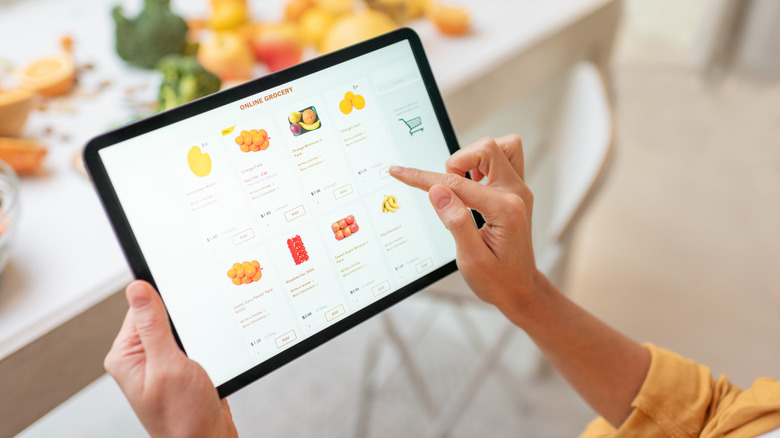Why Online Grocery Shoppers Spend Significantly More Than Those In-Store
With food prices skyrocketing worldwide as a result of record inflation, supply chain issues, trade tariffs, and global conflicts, many consumers are seeking ways to stretch their grocery budget as far as possible (via AP News). According to one recent study, one of the worst ways to save money on groceries is also one of the most convenient options: shopping online.
A recent consumer trends report produced by the marketing company Dunnhumby found that consumers who shopped for groceries online were spending much more, on average, for their essentials.
In recent years, following the onset of the COVID-19 pandemic, the online grocery industry has boomed in response to consumers looking for a safe and easy way to get their everyday essentials delivered directly to their door. In 2020 alone, orders on the grocery delivery platform Instacart increased by 500%, driving the value of the company up to $39 billion (via TechCrunch).
In response to the growing demand, a bevy of on-demand grocery companies (like Gopuff, Gorillas, and Getir) popped up in major cities across the U.S., gaining the attention and funds of major investors. In 2021, one survey found that 60% of U.S consumers were buying groceries online (up from 36% in 2019), and intended to continue shopping online post-pandemic, according to Supermarket News.
However, recent data has indicated that increasing numbers of consumers are returning to in-store shopping, causing investors to shy away from the grocery delivery market and sending valuations of on-demand grocery companies plummeting.
Online shoppers spent hundreds more on groceries per month on average
One reason for this sharp decrease in business could be the added costs associated with shopping online. Not only do grocery delivery companies charge additional fees — like Instacart, which charges delivery fees starting at $3.99 and a 5% service fee — but they also have hidden expenses consumers may not be privy to, notes Healthline.
According to Supermarket News, the average online grocery shopper spends $594 per month on groceries, compared to the $388 per month spent by exclusively in-store shoppers. Although more than 70% of both online and in-store shoppers said that saving money was a major factor in selecting a retailer, data showed that online shoppers tended to spend more — balancing time savings with money savings — compared to in-store shoppers, who focused mainly on cost saving.
Online shoppers, who shopped at 3.9 to 6.6 different stores each month, on average, compared to 3.2 stores by in-store shoppers, were also 10% more likely to have difficulty paying for unforeseen expenses and 6% more likely to reduce meal sizes to save money.
According to the Dunnhumby report, a likely reason for this correlation is the fact that online shoppers were also more likely to have children, pets, and a busier lifestyle, leaving less time to grocery shop and balance a budget. However, as American families grapple with inflation, more and more shoppers may return to the traditional shopping route to shave a few much-needed dollars off their monthly grocery bill.

